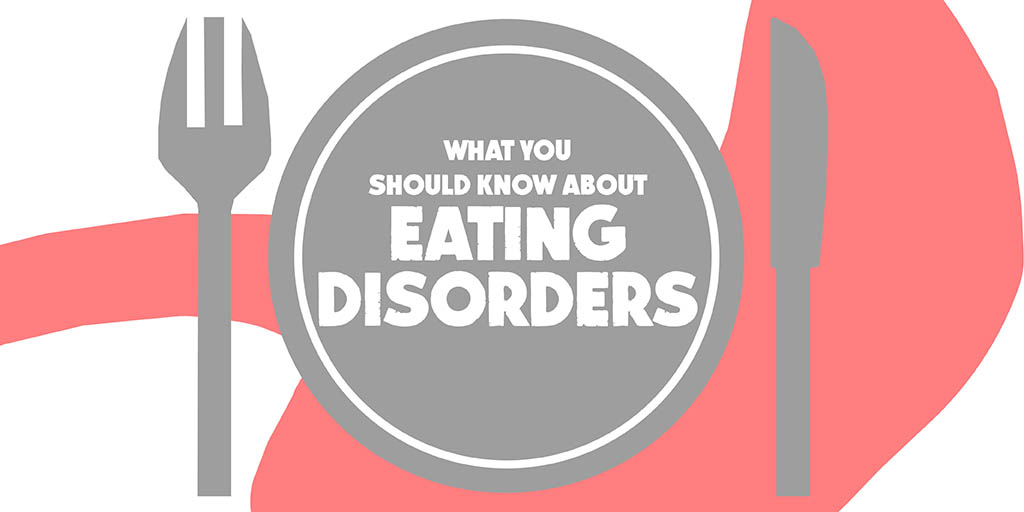What you should know about eating disorders

Eating Disorder Hope (EDH) defines an eating disorder as, “illnesses that are characterized by irregular eating habits and severe distress or concern about body weight or shape”. According to Statistics Canada, 725,800 to 1,088,700 Canadians meet the diagnostic criteria for an eating disorder at any given time and the prevalence of full or partial eating disorders is two per cent in males and 4.8 per cent in females. There are at least three main types of eating disorders including Anorexia Nervosa, Bulimia Nervosa and Binge Eating Disorder.
Anorexia Nervosa
Anorexia Nervosa is an eating disorder where an individual restricts the amount of food intake and/or over exercises to keep their weight under the normal level. According to Healthline, Anorexia Nervosa has the highest mortality rate of all mental illnesses as a result of health problems or suicide. Statistics Canada says that the suicide rate among people with Anorexia Nervosa is 20 to 30 per cent and 50 per cent of individuals with this disorder will develop Bulimia Nervosa within five years. Some of the problems that can arise from Anorexia Nervosa include kidney problems, low blood iron, bone loss, digestive problems, and low blood pressure. Ninety per cent of the cases are female and the majority of cases are onset in mid to late adolescence.
Bulimia Nervosa
Bulimia Nervosa is characterized by uncontrollable binge eating followed by compensating for the food intake often by vomiting or using laxatives (purging). According to Statistics Canada, one to three percent of women will develop this disorder in their lifetime and 90 per cent of the cases are female. To be diagnosed with Bulimia Nervosa, binge eating and purging must occur at least twice per week for a minimum period of three months. According to Canadian Mental Health Organization (CMHA), health problems that can occur from Bulimia Nervosa include kidney problems, dehydration, and digestive problems. Frequent vomiting can also damage the teeth, mouth, and throat.�
Binge Eating Disorder
According to the National Eating Disorder Information Centre (NEDIC), Binge Eating Disorder, often called compulsive overeating, involves the overconsumption of food during a short period of time. Binge Eating Disorder is not the same as over eating as the individual is incapable of knowing when to stop eating. An episode can include eating when not hungry, eating alone due to embarrassment, or eating until painfully full. According to CMHA, Binge Eating Disorder is prevalent in two per cent of all Canadians.�
Neurobiology Behind Eating Disorders
Many people believe that eating disorders are behavioural and individuals with these types of mental illnesses simply have a strong sense of will power. However, there have been several studies to show that eating disorders have a lot to do with the brain and how it processes reward. According to Eating Disorder Hope, brain imaging shows a dysfunction in reward and punishment in the brain in individuals with eating disorders. The part of the brain that is responsible for control is not activated properly in those with Bulimia Nervosa and Binge Eating Disorder. Dopamine, the pleasure chemical, does not show regular responses. People with Anorexia Nervosa show an overproduction of dopamine and those with Bulimia Nervosa show an underproduction of dopamine. One of the reasons why eating disorders, especially Anorexia Nervosa, are harder to treat compared to other mental illnesses is because they are habitual. Habits are formed by brain processes and those with eating disorders show higher activity in the dorsal striatum which is the area linked with habitual behaviour. According to Statistics Canada, 35 per cent of people who are treated for Anorexia Nervosa will relapse.
Treatment
There are several methods to treating each eating disorder. A common therapy used is Cognitive Behavioural Therapy (CBT) which works to help individuals understand their own thoughts and behaviours and make modifications. Family therapy is also common in order to make the entire family understand the illness as there are many misconceptions about eating disorders. Hospitalization will sometimes occur if the patient has developed serious health problems and/or medications such as antidepressants, can also help. Individuals will also be advised to take part in nutritional help and/or support groups.
Warning Signs
Eating disorders can not always be detected by weight loss or gain. There are physical, behavioural, and psychological warning signs that can suggest someone is suffering from an eating disorder. Physical warning signs can include a disturbance of menstruation in females, fainting, fatigue and/or irregular sleep patterns, low energy, and signs of vomiting (swollen cheeks, calluses on knuckles, damaged teeth and bad breath). Psychological warning signs can include anxiety around meal times, distorted body image, or using food as a source for comfort or self punishment. Some of the behavioural warning signs to look out for are extreme dieting, eating in private, frequent trips to the bathroom during or after meals, compulsive exercising, changes in clothing style (wearing baggy clothes), or changes in food preferences.
Contacts for Eating Disorder Supports in London
Hope's Eating Disorders Support
519-434-7721
hopeseds.org
CMHA Middlesex
519-668-0624
cmhamiddlesex.ca
Adult Eating Disorders Service - London Health Sciences Centre
519-685-8380
lhsc.on.ca














